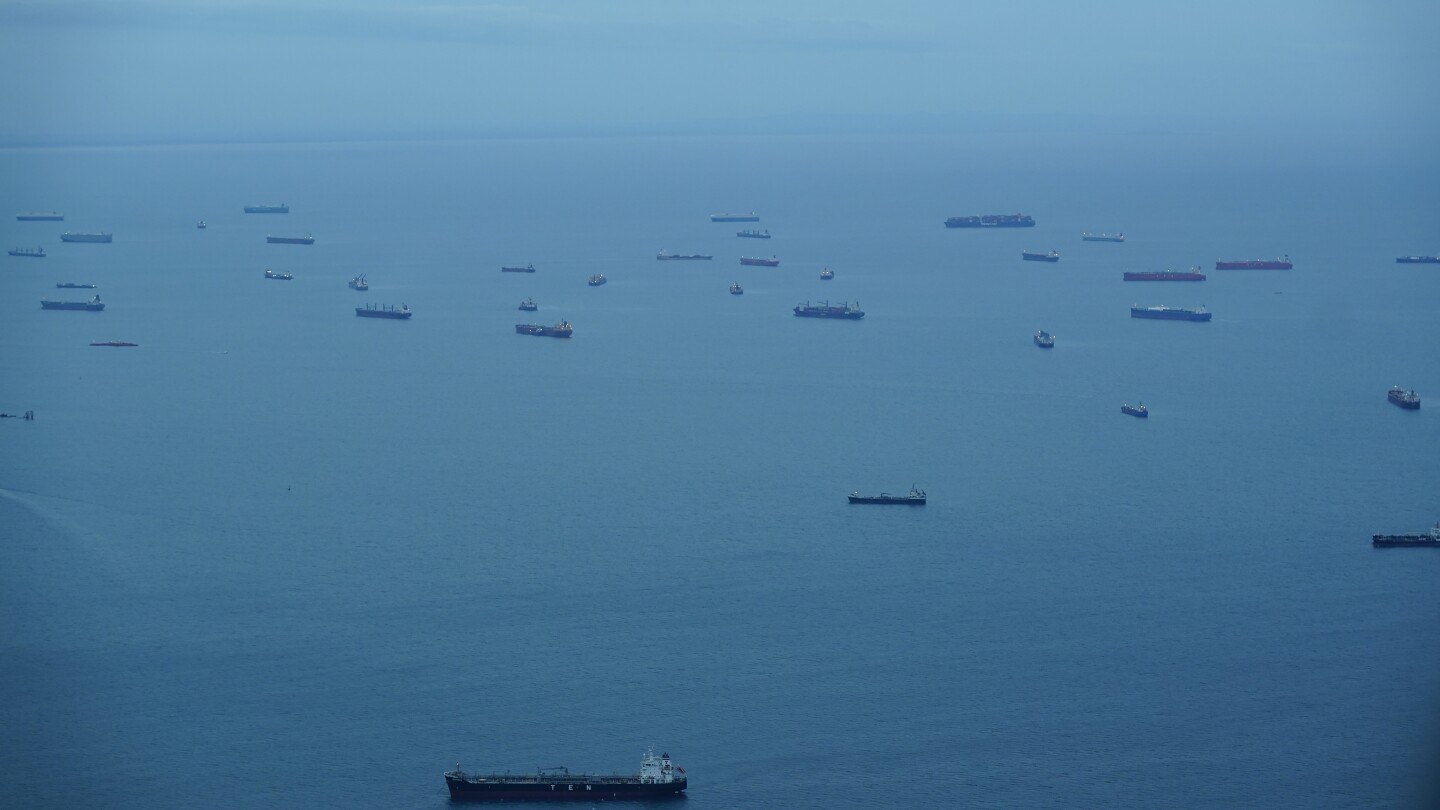The Panama Canal announced Saturday it will reduce the maximum number of ships travelling the waterway to 31 per day, from 32 in August, due to a drought that has reduced the supply of fresh water needed to operate the locks.
That compares to daily averages of 36 to 38 ships per day under normal operation.
Nine ships per day will be allowed to use the new, bigger NeoPanamax locks and 22 per day will be handled through the older Panamax locks.
Why do they need to use fresh water to fill the locks? I get that pumping salt water may come with a bit more maintenance but it just seems like a waste to use all that fresh water.
The middle part of the canal is 26 meters above sea level, and the canal is way too big for them to pump sea water into it.
Easy fix, just dig down that 26 meters!
All the way across the length of the canal.
I’m sure a couple dudes with shovels could knock it out in a week.
Two weeks tops.
So interesting thing
Digging out the height difference and making it a straight shot canal would have VERY BAD ecological consequences.
Sea level on the Pacific side is higher than on the Atlantic side, meaning that opening a straight shot canal would cause the Pacific to begin draining into the Atlantic through the canal
This could have DRASTIC implications for the Caribbean and North Atlantic because, how much Pacific needs to get into the Atlantic before the water tables are balanced‽
plus it allow sea snakes in to the Caribbean
I thought sea levels were the same at the same latitude all around the globe. I feel like I’ve been lying to myself all these years now.
It’s pretty unintuitive because we’re not used to dealing with ocean sized bodies of water in day to day life. Part of the explanation is just that the prevailing winds pile all the water in the Pacific up against the coast, causing higher sea levels on the West Coast. The lower salinity of the Pacific also causes lower water density, which translates to higher sea levels.
Also tides are not the same on both sides, even if they were the same average level, the tides definitely wouldn’t be synchronized. This would result in very strong currents in the canal, making it impossible to safely navigate. The most common fix for that type of situation is to put… locks in the canal.
That’s fucking wild what lol
Easy fix, just dig down that 26 meters!
All the way across the length of the canal.
I’m sure a couple dudes with shovels could knock it out in a week.
Why shovels when you can use plowshares?
Proposed uses for nuclear explosives under Project Plowshare included widening the Panama Canal, constructing a new sea-level waterway through Nicaragua nicknamed the Pan-Atomic Canal …
Or maybe we should stop messing with our climate.
I saw two guys on YouTube dig a whole city in the mud by hand I bet they could totally do it lol
The canal is actually larger than I thought.
As I understand it, canal locks don’t pump water at all.
When you’re going downhill, you allow the higher water to slowly drain out of the lock, thus lowering you to the lower level
When you’re going uphill, you allow the higher water to slowly drain into the lock, thus raising you to the higher level.
In both directions the water is always flowing from high to low.
The canal traverses a fresh water lake at the middle
Because the canal is connected to Gatun Lake, a freshwater lake.
They should use crude oil, it’ll make the boats slippery so they can go through the canal faster.
No need to pay for lubrication of the mechanisms either
I wonder how many of the ships that pass through the canal wouldn’t float in oil because of its lower density.
Energy. It takes a lot of energy to get water that high.
Removed by mod
Way to accuse a county that ranks 61st on the HDI of not solving a problem because they do not fail within what you call good! You’re point is similar to asking why can’t the US solve navigation issues in the Mississippi when there’s a massive drought? And then blaming them poor people in Mississippi. What a pretentious ignorant comer you made.
Your* point.
Removed by mod
Nothing is infinite. But fresh water is renewable, which means it can be used sustainably.
WTF are you on about?
All locks work the same way as these ones, even the most modern locks in the US.
They’re not “powered” by fresh water, they’re using the normal flow of water, harnessed by valve systems, to either allow water to accumulate in the chamber or prevent that accumulation, depending on what they’re trying to achieve. The only energy consumed is a relatively small amount of electricity to power the hydraulics that open and close the valves and the lock gates themselves. Everything else is gravity.
Removed by mod
You should not comment on topics you don’t understand because you sound really, really dumb.
Having traversed the Panama Canal several times in the last 15 years, Pauli’s quote “Das is nicht einmal falsch” comes to mind.
It’s to keep it out of the hands of Nestlé
Humans are fucking stupid.
Not in this case
You are a great example.
Hugs n kisses bb
The world economy about to learn what a 15% reduction in Panama Canal crossings does to supply chains
It might dissuade people from buying an iPhone or computer every year. So much stuff is thrown away prematurely.
EDIT: Nvm that was the Suez canal not Panama.
Wel it will be better than the 100% we had when a ship got stuck, of course that wasn’t a long term thing, this I do not know how long will last.
That got stuck in another canal, not the panama one. Maybe Suez?
Oh yeah right right it was Suez. My shitty memory again. Will edit the post.
With the amount of money, the Panama canal must make; why the flip do they not have backup pumps to hoist water back up into the reservoirs? Old timey dutch windmills would even work…
The most powerful pump in the world would take a half hour to fill a Panama Canal lock from the low level to the high level (by contrast, the gravity-fed system takes only ten minutes to fill it from the lake). That pump is called the Pentair Fairbanks Nijhuis HP1-4000.340; coincidentally it actually is in the Netherlands, and it’s used to control flooding. It cost about $1B (USD) and took over three years to install.
The Panama Canal would need twelve of them; one for each lock. At a total cost of over one billion dollars, the installation would suck up almost a sixth of the nation’s GDP; and each time you filled a lock with one, the electricity alone would cost another $22,400. That means over a quarter of a million dollars for every ship that goes through the twelve locks, which means another $2.5m per day to send ten ships through (and note that number— it would also bring along with it a 66% cut in the possible revenue that the canal can earn from current levels, which are already half of their designed rate) because the slower moving pumps would take three times as long to cycle a lock.
Are there ways to mitigate some of this? Certainly. But I’m trying to communicate the scope of this massive problem that you’re dismissing here. I’m sure they’ve thought about every angle, since it’s something like 40% of their GDP.
Why not pump straight to a top-level reservoir?
Well for one thing, Gatun Lake is now an entire freshwater ecosystem, and breathing to see because of it’s inaccessibility to humans.Turning it brackish would probably have some consequences.
There already is a reservoir, it’s called Gatun Lake. It’s not filled using pumps, though, it’s filled from the rain.
That rain is what’s the problem right now, there’s not enough.
That top-level reservoir is called Gatun Lake. It’s one of the largest artificial freshwater lakes on Earth; pumping seawater into it would be disastrous for fish populations which have already not recovered from the introduction of an invasive species almost 60 years ago; but even more disastrous for the cities of Colón and Panama City, which get their drinking water from Gatun Lake.
Plus, (and take this part with a grain of salt, I haven’t researched it as closely, but the provenance is pretty good) pumping water that far (Gatun Lake is 85ft/26m above sea level and 6mi/9.5km from the ocean on the Atlantic side) would increase costs significantly over just pumping it up a level from one lock to another. The maximum vertical pumping height of a single ideal pump was at one time proven to be 33ft, meaning that pumping from the ocean to the lake would require a system of pumps that wouldn’t reduce installation costs that much and would probably have to run more or less continuously, increasing operating costs.
Hydrology is cool. The forces are gigantic.
Cool! I didn’t know that. Thanks for the info!
My guess is that the water gets contaminated by bilge and other stuff from the cargo ships, which you dont want getting into Gatun Lake.
A. One of the rainiest regions in the world
B. Also a source of drinking water for nearby cities
Maybe they haven’t needed them before now?
Matter of scale. Requires too much water to pump efficiently.
I always thought the locks operated in pairs - raise one side, lower other direction.
This also could be a navigation thing where there is a lack of depth at the top
No, they don’t have pumps or the energy needed to do that all the way to 100%. They do send water from a higher lock to a lower lock until they are both at 50%, but they have to fill the remaining portion from the lake system on top.
This is the best summary I could come up with:
PANAMA CITY (AP) — The Panama Canal announced Saturday it will reduce the maximum number of ships travelling the waterway to 31 per day, from 32 in August, due to a drought that has reduced the supply of fresh water needed to operate the locks.
That compares to daily averages of 36 to 38 ships per day under normal operation.
Nine ships per day will be allowed to use the new, bigger NeoPanamax locks and 22 per day will be handled through the older Panamax locks.
In August, the canal implemented a measure capping the number of ships passing through its locks daily to a maximum of 32.
Not enough rain has fallen to feed the watershed system of rivers and brooks that fill lakes, whose waters in turn fill the locks.
The watershed also supplies freshwater to Panama City, home to about half the country’s 4 million people.
The original article contains 174 words, the summary contains 149 words. Saved 14%. I’m a bot and I’m open source!







